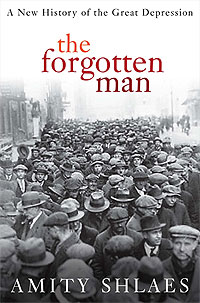The Forgotten Man: A New History of the Great Depression by Amity Shlaes

The Forgotten Man: a New History of the Great Depression published in 2007 is filled with lessons pertinent to the management of today’s depressed economy. The author, Amity Shlaes, discusses the policies that led to the collapse of the world economies in 1929 and the effects of the responses of Presidents Herbert Hoover and Franklin Roosevelt.
The title comes from a lecture given by William Graham Sumner five decades before the Great Depression in which he discussed the laws proposed by progressives to solve the inequities of society. A and B propose to take money from C to give it to X. C is the forgotten man, the one who pays. Roosevelt changed the meaning. In his first major campaign speech for the presidency, he referred to the poor who receive government aid as “the forgotten man.”
Herbert Hoover became President on March 4, 1929. By September 3, the stock market rose to 381, an historic high. Then on Black Tuesday, October 29, 1929, it plunged to 230. Hoover responded with creation of public works programs, and he pushed industry to maintain the wages of workers even as profits plunged. As a result, many businesses shut down, and unemployment rose from three percent to nine percent within three months.
Congress passed the Smoot-Hawley Tariff Act, and Hoover signed it into law on June 17, 1930. Nations retaliated with their own tariffs and international trade plummeted.
Hoover also encouraged legislators to attack Wall Street with prosecutions and investigations of speculators and short sellers. The markets responded with further falls below two hundred.
Deflation swept across the nation, and the FED, instead of pumping money into the economy, tightened the money supply, making loans difficult to obtain.
To make matters worse, Hoover signed the Revenue Act of 1932. It raised the top tax rate from the mid twenties to sixty-three percent, a move that stifled creation of new businesses and hiring of new workers.
Franklin Roosevelt came to power on March 4, 1933, thirty-two days after Adolf Hitler became Chancellor of Germany. Industrial production stood at fifty percent of the 1929 level, farm prices had fallen sixty percent, and two million people were homeless. Banks all over the country were closing their doors.
Roosevelt responded with a massive expansion of the federal government. The National Industrial Recovery Act established the Public Works Administration to create huge public projects such as dams, bridges, schools, and hospitals. It also expanded rights of labor unions, and it created the National Recovery Administration that established extensive regulation over industry and forced government, labor, and industry to work together to control prices and wages as was done in Italy at that time under Mussolini. Many of these arbitrary rules made it difficult to carry on a business. The Supreme Court found this act to be unconstitutional in1935.
The Civilian Conservation Corps (CCC) put 250,000 people to work on local rural projects, and the Tennessee Valley Authority (TVA) oversaw the construction of dams and power stations to provide electricity to poor areas of Tennessee.
The Agricultural Adjustment Act limited farm production by paying farmers to destroy excess livestock and to reframe from planting their lands in order to create shortages and thus increase the value of farm products. The act raised taxes on companies that processed farm goods. The Supreme Court later invalidated the act.
In April 1933 Roosevelt abandoned the gold standard for US currency. Nine months later he reestablished it at a price of $35 per troy ounce instead of the previous $20.67.
Roosevelt felt that unbridled capitalism and greed had caused the depression, and he initiated a string of prosecutions against capitalists, Wall Street leaders, and others who opposed or got in the way of his programs.
In 1935 he started the Works Progress Administrations to provide jobs for millions of workers, the Federal Writers’ Project to hire writers, and the National Youth Administration to give jobs to young people
The Wagner Act greatly increased the power of unions by creating the closed shop whereby a union could keep nonunion people from working at a company, and once a union was in place, it would remain in place with no requirement for election by ratification.
The Social Security Act provided pensions for seniors; and a tax bill in 1935 increased estate taxes, raised the top tax rate to 79 percent, lowered the tax threshold to increase the number of people who paid taxes, and created a graduated corporation tax and a dividend tax. All these taxes stifled investment and prolonged the depression. Why should a man risk losing his money for a new venture when the margin for profit is miniscule?
The number of programs and regulations created is mind-boggling. In 1930, the United States had a per capita income that was one-third higher than Britain. By the end of the 1930s, it had fallen even with Britain. The editors of the Economist attributed the slide to “institutional obstructions to a free flow of capital.”
In 1938 unemployment lay at 17.4 and the Dow Jones Industrial Average was 121. It took the most horrific war of all time to pull this country out of the Great Depression.